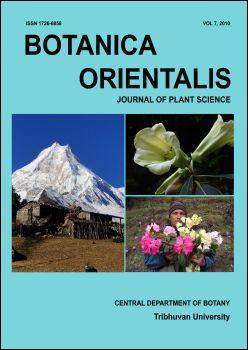Anti-diabetic potential of crude extracts of medicinal plants used as substitutes for <i>Swertia chirayita</i> using <i>in vitro</i> assays
DOI:
https://doi.org/10.3126/botor.v7i0.4373Keywords:
Andrographis paniculata, antioxidant activity, cinnamates, mangiferin, Swertia nervosa, swertiamarin, ?-glucosidase, type-2 diabetesAbstract
Swertia chirayita is a highly traded medicinal plant of Nepal widely used for its anti-diabetic potential. In this study, two herbs (Swertia nervosa and Andrographis paniculata) often used as adulterants and substitutes of Swertia chirayita were analyzed for their antioxidant activity, α-glucosidase inhibitory potential and total phenolic content and compared with that of Swertia chirayita. Aqueous and 12% ethanolic extracts of the three herbs showed moderate to high antioxidant activity and moderate α-glucosidase inhibitory potential. HPLC/ DAD revealed the presence of swertiamarin and mangiferin in all the Swertia species, while Andrographis paniculata contained cinnamates such as cinnamic acid, p-coumaric acid and chlorogenic acid. The antioxidant activity and α-glucosidase inhibitory potential was evident in the two herbs indicating their relevance as substitutes for Swertia chirayita for potential early stage management of type-2 diabetes and related complications.Key-words: Andrographis paniculata; antioxidant activity; cinnamates; mangiferin; Swertia nervosa; swertiamarin; α-glucosidase; type-2 diabetes.
DOI: 10.3126/botor.v7i0.4373
Botanica Orientalis – Journal of Plant Science (2010) 7: 48-55
Downloads
Download data is not yet available.
Abstract
1663
PDF
1272
Downloads
How to Cite
Phoboo, S., Bhowmik, P. C., Jha, P. K., & Shetty, K. (2011). Anti-diabetic potential of crude extracts of medicinal plants used as substitutes for <i>Swertia chirayita</i> using <i>in vitro</i> assays. Botanica Orientalis: Journal of Plant Science, 7, 48–55. https://doi.org/10.3126/botor.v7i0.4373
Issue
Section
Research
License
This license enables reusers to copy and distribute the material in any medium or format in unadapted form only, for noncommercial purposes only, and only so long as attribution is given to the creator.




